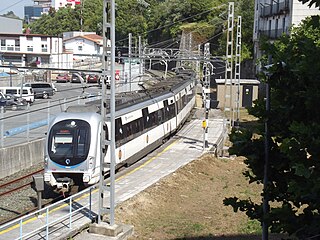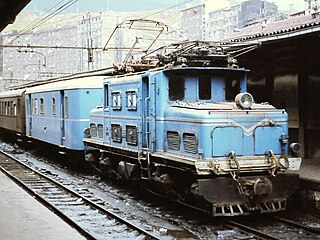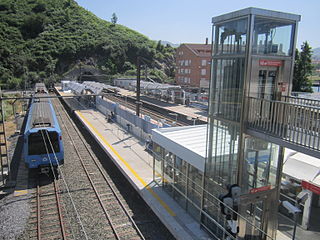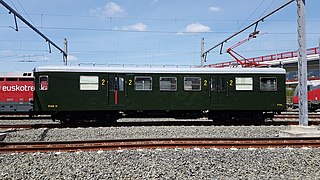
Renfe Cercanías AM, formerly known as Renfe Feve, is a division of state-owned Spanish railway company Renfe Operadora. It operates most of Spain's 1,250 km (777 mi) of metre-gauge railway. This division of Renfe was previously a stand-alone company named FEVE. On 31 December 2012, the Spanish government simplified the organization of state-owned railway companies by merging FEVE into Renfe and Adif. The rolling stock and the brand FEVE were transferred to Renfe, while the infrastructure was transferred to Adif.

Euskotren Trena, formerly known just as Euskotren is a commuter, inter-city and urban transit train-operating company that operates local and inter-city passenger services in the provinces of Biscay and Gipuzkoa, in the Basque Country, Spain. It is one of the four commercial brands under which Euskotren operates, as a public company managed by the Basque government. The entire 181.1-kilometre (112.5 mi) network uses 1,000 mm narrow gauge rail tracks which have been owned by the Basque Government since their transferral from the Spanish government; the rail tracks and stations were part of the FEVE network until its transferral. Euskotren Trena also operates the Donostia/San Sebastián metro under the brand Metro Donostialdea.
Euskotren, formally known as Basque Railways, is a public railway company controlled by the Basque Government and officially established in 1982 to operate several 1,000 mm narrow gauge railways inside the autonomous community of the Basque Country, under the terms of the Statute of Autonomy of the Basque Country. Originally operating under the commercial brand ET/FV, it took control of the management and operations of the narrow gauge lines formerly operated by the railway company FEVE. The commercial brand eventually changed to Euskotren, as it remains today. Since 2006, the infrastructure on which the company runs its trains has been owned by Euskal Trenbide Sarea.

Bilbao-Atxuri is a former terminal railway station in Bilbao, Basque Country (Spain). It served as the terminus station for the commuter rail trains of Euskotren Trena lines to Durango, Bermeo, Eibar and Donostia for over one hundred years.

Lutxana is a station of line 1 of Metro Bilbao, also served by the Lutxana-Sondika shuttle operated by Euskotren Trena. It is located in the neighbourhood of Lutxana-Enekuri, in the municipality of Erandio. In its current inception, the station was opened on 11 November 1995. Since 2015, the station has also been served by Euskotren Trena suburban trains.

Euskotren operates frequent commuter rail services in the city of San Sebastián and the surrounding Donostialdea area, in the Basque Country, Spain. The infrastructure is gradually being upgraded to rapid transit standards, in order to create the San Sebastián Metro. The line is commonly known as Topo, due to the large number of tunnels present. As of 2021, the San Sebastián suburban rail services are branded as part of the Euskotren Trena network, with no separate identity.

The Euskotren 300 series is an electric multiple unit (EMU) train type operated by Euskotren in the Basque Country, Spain from 1990 to 2018.

The Euskotren 3150 series is a railcar train type formerly operated by Euskotren in the Basque Country, Spain. Originally built in the 1960s by Ferrocarriles Vascongados, the series was retired from passenger service in 1997. A refurbished unit, known as Trenbiker, is operated by Euskal Trenbide Sarea as a track geometry car.

The Brown Boveri electric locomotive was an electric locomotive type originally operated by Ferrocarriles Vascongados in the Basque Country, Spain. When that company was absorbed by FEVE, it came to be known as the FEVE 4000 series. It was later operated by Euskotren.

The Euskotren 200 series is an electric multiple unit (EMU) train type operated by Euskotren in the Basque Country, Spain from 1986 to 2018.

The Urdaibai line, also known as the Amorebieta–Bermeo railway is a 29.19 km (18.14 mi) mostly single-track branchline in Biscay, Basque Country. Owned by Euskal Trenbide Sarea, it runs from Bermeo to Amorebieta, connecting with the Bilbao-San Sebastián mainline.

The Lutxana–Sondika line is a single-track branchline in Biscay, Basque Country, Spain. Owned by Euskal Trenbide Sarea, it runs from Lutxana to Sondika, connecting line 1 of the Bilbao metro with the Txorierri line. It is a remnant of the former Lutxana–Mungia line, which was partially closed in May 1975.

The ASEA electric locomotive was an electric locomotive type originally operated by Ferrocarriles Vascongados in the Basque Country, Spain. When that company was absorbed by FEVE, it came to be known as the FEVE 4100 series. It was later operated by Euskotren.

The ASEA electric locomotive was an electric locomotive type originally operated by Ferrocarriles Vascongados in the Basque Country, Spain. When that company was absorbed by FEVE, it came to be known as the FEVE 4200 series. It was later operated by Euskotren.
Euskotren is a public railway operator in the Basque Country, Spain. Its rolling stock is formed by electrical multiple units used for Euskotren Trena commuter rail services, trams running on the Bilbao and Vitoria-Gasteiz tramway networks, and locomotives for hauling freight trains.

Ferrocarriles Vascongados was a railway company in the Basque Country, Spain; founded in 1906 as the merger of three railway companies. It operated the Bilbao-San Sebastián line, as well as the Elorrio branch and the Deba railway. FEVE took over its operations in 1972, which in 1982 were transferred to the new company Basque Railways. Ferrocarriles Vascongados was dissolved in 1995, after more than two decades without activity.

The long Ganz railcar is a railcar train type formerly operated by Ferrocarriles Vascongados in the Basque Country, Spain from 1928 to 1981.

The short Ganz railcar is a railcar train type formerly operated by Ferrocarriles Vascongados in the Basque Country, Spain from 1928 to 1981.
Ferrocarriles y Transportes Suburbanos, commonly known by its acronym FTS, was a railway company in the Basque Country, Spain. Founded in 1947 as the merger of various railway companies, it operated several suburban rail lines in the Greater Bilbao area. FEVE took over its operations in 1972, which in 1982 were transferred to the new company Basque Railways.

The Carde y Escoriaza railcar is a railcar train type formerly operated in the Basque Country, Spain. They were introduced in the Bilbao-Plentzia railway in 1927, and were later operated by Ferrocarriles y Transportes Suburbanos, Euskotren, Metro Bilbao and Euskal Trenbide Sarea until 2012.

















